|
1900
|
Australian Constitution
|
|
| |
Queen Victoria signs the Royal Commission of Assent on 9 July 1900, the Bill providing for the creation of the Commonwealth of Australia. [1]
The Commonwealth of Australia Constitution Act 1900 represents the 'blueprint of the Commonwealth'. It describes how the new federation will be established and provides the authority for the powers of the legislature, the executive and the courts. Section 125 of the Constitution describes how the seat of Government of the Commonwealth will be established:
The seat of Government of the Commonwealth shall be determined by the Parliament, and shall be within territory which shall have been granted to or acquired by the Commonwealth, and shall be vested in and belong to the Commonwealth, and shall be in the State of New South Wales, and be distant not less than one hundred miles from Sydney. Such territory shall contain an area of not less than one hundred square miles, and such portion thereof as shall consist of Crown lands shall be granted to the Commonwealth without any payment therefor. The Parliament shall sit at Melbourne until it meet at the seat of Government. [2]
|
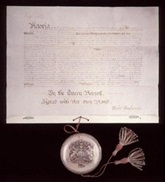
Royal Assent of Queen Victoria to Commonwealth of Australia Constitution Act of 1900
Image courtesy of Gifts Collection, Parliament House Art Collection, Canberra ACT
|
|
1900
|
Commonwealth of Australia
|
|
| |
On 17 September 1900, Queen Victoria proclaims that the Commonwealth of Australia will come into existence on 1 January 1901. [3]
|
|
|
1901
|
Federation
|
|
| |
Australia becomes a nation on 1 January 1901 when the six colonies federate, and the Commonwealth of Australia is proclaimed in Centennial Park, Sydney.
Lord Hopetoun is appointed as Australia’s first Governor-General. Edmund Barton (Protectionist, Member for Hunter, NSW, 1901‒03) is sworn in as Australia’s first Prime Minister.
|
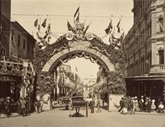
Street decorations for Federation celebrations, 1900‒1901
Image courtesy of Historic Memorials Collection, Parliament House Art Collection, Canberra ACT
|
|
1901
|
First Commonwealth Parliament
|
|
| |
On 9 May 1901, the first Parliament of the Commonwealth of Australia is opened by His Royal Highness The Duke of York and Cornwall (later George V), on behalf of King Edward VII.
The members of the Australian Parliament assemble for the first time in Melbourne on 9 May 1901. As a result of polls held in all states on 29 or 30 March 1901, the Parliament comprises 111 members (36 senators and 75 members of the House of Representatives). The Constitution provided the wording for oath and affirmation, made by every senator or member since 1901, before taking his or her seat:
I, A.B., do swear that I will be faithful and bear true allegiance to His Majesty King Edward the Seventh, His heirs and successors according to law. SO HELP ME GOD!
I, A.B., do solemnly and sincerely affirm and declare that I will be faithful and bear true allegiance to His Majesty King Edward the Seventh, His heirs and successors according to law. [4]
The opening of the first Commonwealth Parliament takes place at the Exhibition Building, Melbourne, and is captured in a painting by Tom Roberts on display in Parliament House. The new Constitution specifies that 'The Parliament shall sit at Melbourne until it meet at the seat of Government'. [5] The location is not specified, although the predominant view is that the new Commonwealth Parliament should occupy the State Parliament building in Spring Street. The matter is the subject of debate amongst the State parliamentarians, some of whom express reservations about having to move from their building. In 1900, however, the Victorian Parliament passes the Commonwealth Arrangements Act 1900 containing provision for the Commonwealth to occupy either the State Parliament building or the Exhibition Building. The Victorian Premier, Alexander Peacock, writes to the Prime Minister, the Rt Hon. Edmund Barton (later Sir) (PROT, Member for Hunter, NSW, 1901‒03), asking which building the Commonwealth Parliament will select to use. The Prime Minister inspects both sites with members of his ministry, and advises that the Commonwealth has chosen the State Parliament House. The Commonwealth Parliament meets in the State Parliament building for 26 years following Federation, much longer than anticipated in 1901, and moves to Canberra when the provisional Parliament House is opened in 1927. During this period, the Victorian State Parliament occupies the Exhibition Building. [6]
|

Opening of the First Parliament of the Commonwealth of Australia by H.R.H. The Duke of Cornwall and York (Later King George V), May 9, 1901. (1903) by Tom Roberts (1856-1931)
On permanent loan to the Parliament of Australia from the British Royal Collection. Courtesy of Parliament House Art Collection, Canberra ACT Photo credit: Matt Kelso
|
|
1901
|
Federal Capital congress
|
|
| |
The Congress of Engineers, Architects, Surveyors and Others Interested in the Building of the Federal Capital of Australia meet in Melbourne from 6‒17 May 1901, coinciding with the opening of the first Commonwealth Parliament, resolving that 'the Federal Capital should be laid out in the most perfect manner possible'. [7]
|
|
|
1901
|
Locating Australia's capital city
|
|
| |
The process of finding a location for the nation's Parliament House begins, in accordance with the directions for the national capital laid out in Section 125 of the Australian Constitution:
The seat of Government of the Commonwealth shall be determined by the Parliament, and shall be within territory which shall have been granted to or acquired by the Commonwealth, and shall be vested in and belong to the Commonwealth, and shall be in the State of New South Wales, and be distant not less than one hundred miles from Sydney. Such territory shall contain an area of not less than one hundred square miles, and such portion thereof as shall consist of Crown lands shall be granted to the Commonwealth without any payment therefor. The Parliament shall sit at Melbourne until it meet at the seat of Government. [8]
It proves to be a complex process requiring protracted investigation and debate, taking until 1909 for Parliament to decide that the new capital would be in the southern part of New South Wales, on the site which is now Canberra. [9]
|
|
|
1902
|
Inspecting possible sites
|
|
| |
In February 1902 senators and members of the House of Representatives make the first of several tours of potential sites for the national capital. [10]
|
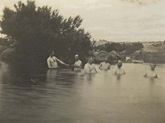
Senators bathing in the Snowy River at Dalgety [picture], 1902
Image courtesy of National Library of Australia

Commonwealth of Australia: complete summary of information with regard to proposed federal capital sites, 19 February 1902
Image courtesy of National Archives of Australia |
| 1902 |
Extending the franchise |
|
| |
The Commonwealth Franchise Act 1902 sets out who can vote in elections for the new Commonwealth Parliament. Women in the states without female suffrage (NSW, Tasmania, Queensland and Victoria) gain the right to vote (section 3). Those excluded from voting include those of unsound mind, persons imprisoned for one year or longer, and ‘aboriginal native[s] of Australia Asia Africa or the Islands of the Pacific except New Zealand’ unless so entitled under section 41 of the Constitution (section 4).
The Commonwealth Electoral Act 1924 makes voting compulsory and establishes penalties for failure to vote. A 1925 amendment to the Franchise Act extends the right to vote to all naturalised Australians. In 1949, the franchise is extended to Aboriginal veterans; and the right to vote is extended to all Aboriginal adults in 1962, with enrolment made compulsory in 1863.
|
|
|
1903
|
Royal Commission on Sites for the Seat of Government
|
|
| |
The Capital Sites Enquiry Board, appointed in 1902 by the Hon. Sir William Lyne (PROT, IND, Member for Hume, NSW, 1901‒13), the first Minister for Home Affairs, examines nine potential sites for the capital city of the new nation: Albury, Armidale, Bathurst, Bombala, Dalgety, Lake George, Lyndhurst, Orange and Tumut. The Royal Commission on Sites for the Seat of Government of the Commonwealth is subsequently established, and the Commission report is tabled in the Commonwealth Parliament on 17 July 1903. The Commissioners favour Albury or Tumut.[11]
|
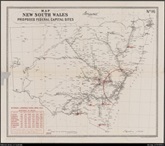
New South Wales. Department of Lands. Map of New South Wales showing proposed Federal Capital sites. No. 16 [cartographic material], 1903
Image courtesy of National Library of Australia
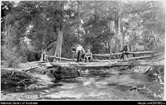
Members of the Board appointed to report upon sites for the Federal Capital at Cotter River,Canberra, ca. 1909 [picture], ca. 1909
Image courtesy of National Library of Australia
|
|
1903
|
Ballot to determine site
|
|
| |
The Hon. Sir William Lyne (PROT, IND, Member for Hume, NSW, 1901‒13) introduces a Seat of Government Bill which results in a House of Representatives ballot in October 1903 to decide on a site for the nation's capital. Tumut is selected but the Senate amends the Bill replacing Tumut with Bombala, and the matter remains unresolved while the nation votes at the second Commonwealth election in 1903. [12]
|
|
|
1904
|
Surveyor's report
|
|
| |
Surveyor Charles Scrivener reports on site options for the national capital and recommends Dalgety. [13]
|
|
|
1904
|
Seat of Government Act 1904
|
|
| |
The second Commonwealth Parliament passes a Seat of Government Act on 15 August 1904, confirming Dalgety as the site of the future national capital.
The NSW Government disagrees and refuses to cede the land to the Commonwealth. The Watson Government loses office two days later, and successive governments continue to debate where the new capital should be located. [14]
|
|
|
1908
|
Site chosen for Canberra
|
|
| |
After seven years of debate on the most suitable site for the new capital, and following a further ballot between Dalgety and Yass-Canberra, the Commonwealth Parliament passes the Seat of Government Act 1908 on 14 December 1908, designating the Yass‒Queanbeyan area for Australia's Capital Territory. [15]
The Act repeals the Seat of Government Act 1904, which had determined an area near Dalgety. This choice was unacceptable to the Government of New South Wales, and the matter was reconsidered. The NSW Government cedes land in the Yass‒Canberra district by the Seat of Government Surrender Act 1909. [16]
|

Seat of Government Act 1908
National Archives of Australia
|
|
1909
|
Acquiring territory for Canberra
|
|
| |
An Agreement of Surrender is signed by NSW Premier Charles Wade and Prime Minister Alfred Deakin (PROT 1901-1910; Lib 1910-13, member for Ballarat) in October 1909.
This is ratified when the Commonwealth Parliament passes the Seat of Government Acceptance Act 1909 and the New South Wales Parliament passes the Seat of Government Surrender Act 1909 enabling the Commonwealth to formally acquire the territory for the new capital from New South Wales.[17] These Acts take effect on 1 January 1911.
As a result of this transfer, residents of the Territory lose all political representation. They do not regain full voting rights at the Federal level until 1966. (While the first representative for the Australian Capital Territory is elected in 1949, the member can vote only on matters relating to the ACT). The passage of the Senate (Representation of Territories) Act 1973 provides for the representation of the ACT, NT and the Jervis Bay Territory in the Senate. Residents of the Territory are not represented at the local level until the granting of self-government in 1989. Residents of the ACT cannot participate in in constitutional referenda until 1977.[18]
The Territory is known as the Federal Capital Territory until 1938, when it is renamed the Australian Capital Territory by the Seat of Government Acceptance Act 1938 (No 12 of 1938).
|
|
|
1909
|
Surveying Canberra
|
|
| |
Following the Commonwealth's acceptance of a capital in the Yass‒Canberra district, Prime Minister the Hon. Andrew Fisher chooses Charles Scrivener to determine the best site for the new capital.
In March 1909 Scrivener establishes a camp on the slopes of Kurrajong (later Capital) Hill to undertake his survey work. [19] Between 1908 and 1914 Scrivener produces a large number of maps and at least three major contour maps of the Canberra city site. His second contour map, produced in 1910, is circulated to entrants in the national capital city design competition, which is ultimately won by Walter Burley Griffin. [20]
|
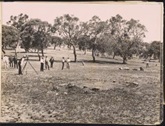
George Fuller taking the first sight in the preliminary contour survey, Camp Hill, 1909
Image courtesy of National Library of Australia
|
|
1909‒10
|
Scrivener's survey camps
|
|
| |
Charles Scrivener establishes survey camps in 1909 and 1910 on the hill at the foot of Kurrajong Hill known as Camp Hill. The first camp is dismantled after three weeks, and another camp set up in the same area in 1910.
A concrete building survives from this period and is entered in the ACT Heritage Register. The building, known as 'Surveyors' Hut', is all that remains of the original Federal Capital Survey camp. It is also one of the earliest extant Commonwealth buildings in the Australian Capital Territory. [21] Many such camps are subsequently established to accommodate workers.
|

Federal Capital site survey camp, Camp Hill, Canberra, Australian Capital Territory, ca 1909
Image courtesy of National Library of Australia
|
|
1911
|
Commonwealth acquires control of Federal Capital Territory
|
|
| |
On 1 January 1911 the Commonwealth Government assumes control of the Northern Territory and the Federal Capital Territory , after the New South Wales Parliament passes legislation to cede 2360 square kilometres of land, including the seaport of Jervis Bay. [22]
|
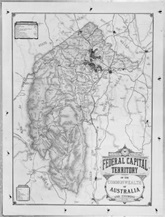
A 1933 map of the Federal Capital Territory
Image courtesy of National Archives of Australia
|
|
1911
|
Design competition launched
|
|
| |
On 30 April 1911 the Commonwealth Government launches an international design competition for the Federal Capital City.
The design brief requires entrants to ‘embody in their Designs all recent developments in the science of town planning’.[23] 137 entries are received and examined by a technical board comprising John Kirkpatrick (architect), James Alexander Smith (engineer) and John Montgomery Coane (surveyor).
The Hon King O’Malley, Minister of State for Home Affairs (IND 1901, Member for Tas.; ALP 1901‒17, Member for Darwin, retains authority over the final decision. The three are unable to agree on the winner and runners up from a shortlist of 46, with Kirkpatrick and Smith reporting in favour of Griffin’s design but Coane, chair of the board, preferring a local design. In May 2012, the board provides O’Malley with majority and minoring reports. Following consultation with other ministers, O’Malley adjudicates the result and accepts the majority report.[24]
|

Canberra federal site from Rottenbury trig station, city series [picture]. Part of Australia. Department of Home Affairs. Lands and Surveys Branch
Image courtesy of National Library of Australia
|